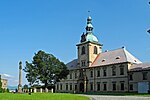Freiberger Mulde

The Freiberger Mulde (also called the Östliche Mulde or Eastern Mulde; Czech: Freiberská Mulda) is the right-hand, 124-kilometre-long (77 mi) headstream of the river Mulde, whose catchment covers an area of 2,981 km2 (1,151 sq mi) in the Czech Republic and Germany in central Saxony. It has a volumetric flow of 35.3 m3/s (1,250 cu ft/s) which is greater than that of the other headstream, the Zwickauer Mulde (or Westliche Mulde or Western Mulde) who flow is about 26.4 m3/s (930 cu ft/s), which is nevertheless the longer stream. The source of the river is in the Ore Mountains, near Moldava, in the Czech Republic. It runs northwest, crossing the border with Germany after a few km, to Freiberg (hence the name), and further northwest through Nossen, Döbeln and Leisnig. A few km north of Colditz, the Freiberger Mulde is joined by the Zwickauer Mulde to form the Mulde. The Mulde is a tributary of the Elbe.
Excerpt from the Wikipedia article Freiberger Mulde (License: CC BY-SA 3.0, Authors, Images).Freiberger Mulde
01312, okres Teplice
Geographical coordinates (GPS) Address Nearby Places Show on map
Geographical coordinates (GPS)
| Latitude | Longitude |
|---|---|
| N 50.70722 ° | E 13.67167 ° |
Address
01312
417 81 okres Teplice, Oldřiš u Moldavy
Czechia
Open on Google Maps









